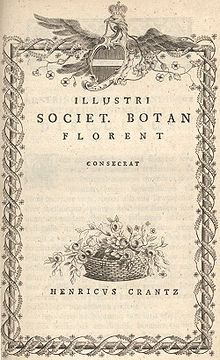Heinrich Johann Nepomuk von Crantz | |
|---|---|
 Classis cruciformium emendata cum figuris aeneis in necessarium instit. rei herbariae supplementum (1769) | |
| Born | 25 November 1722 |
| Died | 18 January 1799 (aged 76) |
| Alma mater | University of Vienna |
| Spouses |
|
| Scientific career | |
| Fields | Botany, medicine |
| Institutions |
|
Heinrich Johann Nepomuk von Crantz (Roodt-sur-Eisch, Luxembourg, 25 November 1722 – 18 January 1799, Judenburg, Austria) was a botanist and a physician.
In 1750 he obtained his doctorate of medicine in Vienna, where he was a pupil of Gerard van Swieten (1700–1772). He studied obstetrics in Paris and London. In Paris he was influenced by André Levret (1703–1780) and Nicolas Puzos (1686–1753).[1]
He was first married to Anna Susanne Petrasch and then to Magda Lena de Tremon. He had two sons and one daughter.[1]
He became a lecturer in obstetrics at St. Mary's Hospital in Vienna in 1754. From 1756 to 1774, he taught physiology and materia medica at the university in that city.[1]
He was the author of:
He recommended better methods of hygiene for midwives. In addition to his work in medicine, he studied chemistry, botany, and the sources of mineral water.[1] The plant genus Crantzia (Gesneriaceae) was named for him by Thomas Nuttall.[2]